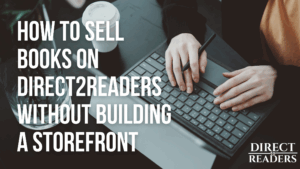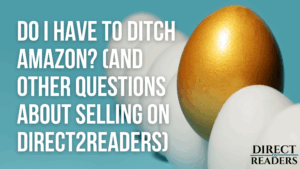Keep More, Know More: What Selling Direct on Direct2Readers Really Gets You

There’s a moment in nearly every indie author’s career when the numbers stop adding up.
You look at your royalties. You look at your ad spend. You look at your newsletter open rates and your sales reports and your carefully curated backlist. And somewhere in that spreadsheet haze, a question creeps in:
There’s a moment in nearly every indie author’s career when you realize you’re doing everything right—writing the books, building the list, showing up for launches—and yet the money still feels like it’s vanishing into a black hole.
You double-check your royalty report. Subtract the ad spend. Squint at the return on investment from your last big promo push. Maybe it was BookBub. Maybe it was Facebook ads. Maybe it was just the slow drip of time and effort that comes from feeding a machine you don’t control.
And still, you wonder: How is it that I can sell this many books and make this little money?
You’re not alone. For many authors, the hard truth isn’t that the books aren’t selling—it’s that the model they’re sold through is siphoning away too much of the reward. Platforms take their percentage. Ad networks take theirs. And what’s left over—aside from a sense of mild whiplash—is a number in your bank account that rarely reflects the work that went into earning it.
But what if there was a way to change the math?
Selling direct isn’t a new concept. It’s been the holy grail for indie authors for over a decade. Control the sale, keep more of the money, know your customer—it sounds like a dream. But for most of us, that dream has always come with a catch.
Usually, it involves learning an entirely new tech stack. WooCommerce, Shopify, delivery tools, payment processors, email integrations. Some authors thrive with that kind of setup. Others burn out just trying to get a buy button to appear. And for every author who’s managed to cobble together a working storefront, there are dozens who gave up halfway through the tutorial.
That’s why Direct2Readers feels like a shift in the landscape—not because it reinvents the idea of selling direct, but because it makes it usable.
Instead of demanding you build a storefront from scratch, D2R acts as a professional discovery layer—complete with optional checkout, built-in delivery, and zero plugins. You upload your book files, set the price, and—if you choose to enable direct sales—you get 80% of the revenue. There’s no monthly fee. No fiddling with DNS records. No e-commerce setup that makes you want to throw your laptop across the room.
It’s direct sales without the e-commerce hangover.
But the real power of selling direct through D2R goes beyond the money.
Because here’s the part no one talks about: when you sell a book through a retailer, you rarely know who bought it. You can’t follow up. You can’t build a relationship. You can’t turn that one-time buyer into a long-term reader—at least not easily.
In short, you lose the reader.
On Direct2Readers, when someone buys your book directly, you get paid—and you get data. That means you can invite them to your email list, track what’s working, offer future titles or bonuses, and build a real connection. Not a random follower or anonymous download—a person who chose to buy from you, and now belongs in your world.
That’s where real growth starts. Not in clicks. In relationships.
And here’s where it gets interesting:
You don’t have to sell every book directly. In fact, you don’t have to sell any of them directly if you don’t want to.
That’s the difference between Direct2Readers and traditional storefront tools. D2R isn’t forcing you to pick a side—it’s giving you options. You can list every title and decide, book by book, how you want the sale to flow.
Send one to your print distributor. Another to your personal shop. Keep your KU titles linked to their appropriate pages, and offer an exclusive novella for direct sale on D2R only. The power is in your hands, not behind a login screen or buried in a terms-of-service agreement.
There’s no algorithm penalizing your choices. No ranking to chase. Just a system built around flexibility—because every author’s business model is a little different, and you deserve tools that reflect that.
The truth is, indie publishing has grown up. The authors succeeding today aren’t just writing good books—they’re thinking like business owners. They’re looking at margins. At retention. At lifetime value. At creative control.
Selling direct doesn’t mean abandoning the old systems. It means adding a new one that puts you first.
If you’re exclusive, D2R works. If you’re wide, D2R works. If you’re doing hybrid launches, bundles, serialized fiction, backlist promos, or special editions, D2R works. It’s not a replacement for your career—it’s a reinforcement.
It’s the tool that catches the sales—and the readers—you’d otherwise lose.
You’ve already done the hardest part: writing the books, building your audience, staying in the game. Selling direct shouldn’t be a barrier. It should be a bridge.
And now, it finally is.
You already know the answer, of course. Retailers take their cut—often a big one. Ad platforms drain the rest. You’re left with a sliver of the sale and, if you’re lucky, a reader you’ll probably never hear from again. They bought the book, but the platform kept the relationship.
It’s not personal. It’s just the model.
And for a while, most of us go along with it.
But what if there was another way?
Selling direct isn’t a new idea. Authors have been experimenting with it for years, through Shopify stores, PayPal links, even hand-selling at events. The challenge has never been the concept—it’s been the infrastructure. You want the benefits of direct sales, but not the pressure of becoming your own tech department.
That’s where Direct2Readers changes the equation.
Rather than asking authors to build a storefront from scratch or manage every aspect of digital delivery, D2R offers something simpler: a place to list your books, connect with readers, and, when you’re ready, sell directly—without needing a single plugin.
It’s direct sales, minus the chaos.
Set your price, upload your files, click a button. Direct checkout is enabled, and with it, a direct line to the reader who just supported your work. There’s no monthly fee, no storefront to maintain, and no complex funnel to build. D2R handles the transaction, delivers the file, and sends you 80% of the sale.
But the real value isn’t just the money.
When a reader buys through Direct2Readers, you know who they are. Not in a creepy, data-hoarding kind of way, but in a business-building kind of way. You can reach out. Invite them to your newsletter. Ask for feedback. Offer bonuses or early access. Build a relationship that outlives the transaction.
Compare that to the traditional model, where most of your readers vanish into a retailer’s dashboard—visible only as numbers and vague impressions.
Owning that connection changes things. It’s how long-term careers are built—not just by finding readers, but by keeping them.
Of course, not every book needs to be sold direct. Maybe you’re exclusive. Maybe you’re wide. Maybe you’ve got a Kickstarter running, a BookFunnel bundle live, and a linktree full of choices.
Direct2Readers doesn’t ask you to change that. You don’t have to go all in or all out. You don’t have to pull your titles from anywhere or make your life more complicated. That’s the point.
You can choose—title by title, campaign by campaign—whether to link to a retailer, point to your existing store, or enable direct checkout right on the platform. It’s not about abandoning what works. It’s about adding something that works for you.
If the author economy is going to thrive, it has to give authors more than a sales report. It has to give them options. Direct2Readers is built on that premise: that control, flexibility, and visibility shouldn’t require coding skills or a customer support ticket. They should be available to any author ready to take the next step—not into a new platform, but into ownership.
You don’t need to be a tech wizard. You don’t need a storefront. You just need a story worth selling—which, if you’re reading this, you already have.
Tags :
Share :

Chelle Honiker
Latest Post

How to Sell Books on Direct2Readers Without Building a Storefront
What Flexible Discovery Really Means—And Why Indie Authors Should Care

Keep More, Know More: What Selling Direct on Direct2Readers Really Gets You

Do I Have to Ditch Amazon? (And Other Questions About Selling on Direct2Readers)

